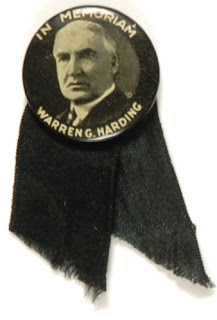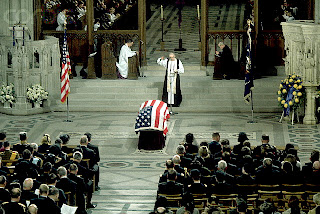One of the saddest moments in history is when the President of the United States dies unexpectedly in office. For the first 50 years of the presidency, death of a chief executive was something the country had not dealt with. In 1841, William Henry Harrison caught pneumonia while giving his inaugural address, and died on April 4, 1841, one month after taking office. The country was in shock and went into a state of mourning, as Harrison had been a war hero and greatly loved by the people. Many memorial ribbons were created honoring the late Harrison. A huge memorial was eventually erected in North Bend, OH where he presently rests, a theme that would become common for presidents who died in office. Just nine years later, another Whig, Zachary Taylor, fell ill at a July 4th celebration in Washington, and died a few days later. Once again, this sudden passing of a president sent the nation into a time of mourning. One of the biggest and most important losses of a president came in 1865, when Abraham Lincoln was assassinated, the first in American history. The country had just wrapped up most of the Civil War, and victory celebrations were going on in a lot of places in the North. Lincoln's death also caused an uproar and demand for justice, which came a little later with the hanging of John Wilkes Booth's companions. The Lincoln funeral train was very long, hitting major cities in the East and Midwest, before reaching Springfield, Illinois. The second presidential assassination came in 1881, when James Garfield was gunned down at a railroad station near Washington. This death was treated much like Lincoln's, with many black ribbons and items made to honor Garfield. The White House was also draped in black cloth. Twenty years later, another president would fall to the assassin's bullet, this time William McKinley, while in Buffalo, NY. There was tremendous mourning for McKinley, and many buttons, ribbons, and memorials were made in his honor, topped off by an impressive grave site in Canton, Ohio. The next president to die in office was Warren Harding, in 1923, due to illness or heart issues. This was once again a shock to the nation, as the scandals that plagued Harding's reputation were not yet fully known. The Harding Memorial Commission was formed and headed by Calvin Coolidge, raising thousands of dollars for a memorial. Franklin D. Roosevelt was leading the country towards the end of World War II when he suddenly died while visiting Warm Springs, GA in April of 1945. Roosevelt's death was mourned not just in America, but in much of Europe. One of the most tragic presidential deaths was that of John F. Kennedy, especially at such a young age. With the age of television, Kennedy's funeral was televised, bringing millions of people into the mourning and funeral procession. Every time a president passes away, it is big news, whether they had been out of office three months or thirty years. John Adams and Thomas Jefferson shared the fate of dying on the same day, July 4, 1826, causing a rare moment in history in which two great figures die on the same day. James Monroe trailed behind Jefferson and Adams by five years, dying on July 4, 1831. John Quincy Adams was the first president to die in Washington, D.C., dying in the U.S. Capitol building. John Tyler's death was not recognized officially by the United States, as Tyler had been elected to the Confederate Congress, dying shortly after that. James K. Polk only lived three months after leaving the White House, the shortest time of any presidential retirement. Herbert Hoover lived the longest amount of time after leaving Washington, although Jimmy Carter can pass that mark in the next few months. Gerald Ford and Ronald Reagan both lived to be over 90 years old. Since Richard Nixon's death, all funerals for presidents have become nationwide events and often held at Washington's National Cathedral, and all former living presidents attend. Below, I have pictured some items made for memorials or in honor of presidents. A few of these I own, and a few of them I borrowed from past auctions to show a wider variety.
Garfield Memorial ribbon, 1881
Grant ribbon, 1885
Warren G. Harding memorial button and ribbon
William McKinley memorial button
William H. Harrison ribbon, 1841
John F. Kennedy memorial button
Dwight D. Eisenhower's funeral, National Cathedral
Franklin D. Roosevelt's funeral
John F. Kennedy's funeral
William McKinley's funeral
The living presidents at Ronald Reagan's funeral, 2004











































